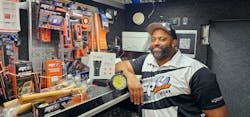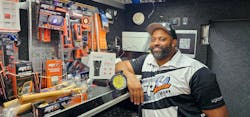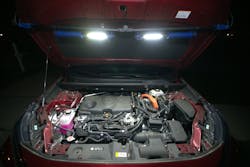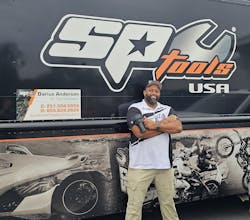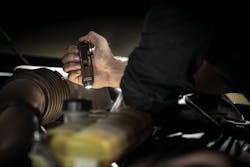Though often overlooked and taken for granted, lighting is an essential part of any technician’s tool repertoire. Overhead lighting isn’t always enough, especially when technicians are trying to look in at a vehicle’s engine or peer up from underneath a car at its inner workings. Good lighting provides the ability to get a job done more quickly, efficiently, and safely.
While some may believe a light is a light is a light, mobile tool distributors like SP Tools USA’s Darius Anderson know better.
The Robertsdale, Alabama-based distributor keeps an assortment of lighting products on his tool truck to keep his variety of customers stocked up. From servicing independent shops to dealerships to heavy duty and tractor stores, Anderson makes sure to have a little something for everybody. And with his supply of COB lights, work lights, torch lights, and much more from SP Tools USA, AceBeam, and Maxxeon, he has plenty of options available.
This suits the distributor very well as he notes that he sells about one lighting product a day.
“Everybody needs lighting,” he says. “If you don't have the right lighting, you can't do the job properly. I mean, that's just how it is.”
A shift in lighting
With everyone having a need for lighting, and different needs at that, it makes sense that lighting has had to adapt over the last decade or so to better fill those needs.
“A lot of changes have been made,” explains Mike Schira, sales manager for Maxxeon. “Like any category in the tool industry, it's taking what you currently have and improving what exists in terms of specifications and durability.”
In the past, durability with lighting was a major issue. Between the halogen and incandescent bulbs in previous lighting products, any dropping of the light was likely to lead to a broken bulb, and the short lifespan of the bulbs meant frequent replacing. These bulbs were also quite the safety hazard. Even just brushing up against the light could be dangerous, as the bulbs would get hot enough to burn any unlucky individuals who got too close.
Nowadays, LEDs dominate the lighting scene, providing a longer-lasting, more durable, and cool-to-the-touch alternative. Not only that, but LEDs are far more energy efficient.
Marcus Burzynski, vice president of sales and marketing for NextLED, explains that in LED technology, it's roughly 80 to 100 lumens per watt, whereas incandescent bulbs are somewhere around 16 to 20 lumens per watt.
In addition to the switch to LED, the batteries and rechargeability of lighting products have also advanced. Many lighting products now house a rechargeable lithium-ion battery paired with a USB-C charging cable. With the USB-C cable being seen as the universal charging cord, this offers shops and technicians versatility with charging as lighting products from different brands can all be charged using the same cord.
Picking the right light
When it comes to selling his lighting products, Anderson makes sure his customers buy what they need for the job they’re doing. While some customers come more prepared, having done their own research, others rely more on the distributor’s expertise.
“I'm not going to give a lube tech the most expensive [light] because that's not what [they] need,” Anderson says, “but I'm not also gonna sell [them] something that is not up to par to what [they] need.”
There are a few different lights every technician should consider having in their arsenal – handheld lights, work lights, wearable lights, and pocket lights.
Streamlight’s Eric Pike, director of automotive, hardware, and ecommerce, describes the different functions of each category.
- Handheld lights – general purpose use
- Work lights – illuminate a specific space
- Wearable lights (like headlamps or neck lights) – allow for handsfree use
- Pocket lights – a quick access light for repairs or inspections
In addition to those four categories, there are a few specialized lighting categories – color-matching lights and leak-detection lights. A light like Streamlight’s Stinger Color-Rite light would aid technicians with color-matching, as the light uses a high-color rendering index LED which allows technicians to see the color spectrum as they would in natural light. For leak-detection, Maxxeon’s LumaStik Combo UV and White Beam Inspection Light is designed to assist with detecting leaks as well as vehicle cracks and defects.
Moving outside of what a technician may keep in their own toolset, there are a few lights that shop owners may keep on hand for use as needed, particularly tripods, flood lights, and/or scene lights. These lights all work well to illuminate larger areas when overhead lighting just isn’t cutting it. For example, NextLED’s Cordless Tripod Work Light offers six lighting modes and features a magnetic detachable lamp head to ensure optimum positioning.
Regardless of the many options for lighting products available, keep in mind that just as a technician chooses which impact wrench they like best, lighting can also be a more personal choice.
“The funny thing about lighting is it's unique,” NextLED’s Burzynski notes. “There are a lot of different solutions and finding what works best. Sometimes it’s that personal choice from the technician – what they get most comfortable using for that specific application. It's interesting how lighting really becomes a little bit more personal.”
All in the details
Step one may be helping your customers figure out the type of lighting product they need, but step two focuses more on the nitty-gritty details. With a multitude of pocket lights, wearable lights, etc. to choose from, you’ll want to break their options down further by asking some questions about what exactly they want from this tool.
Shop environment
To start, have your customer consider their shop’s environment. How large is the shop? One bay? Two? 10? Depending on what they need the light for the size of the shop could matter. Same goes for the type of vehicles they are working on. The lighting needs for working on a light duty vehicle versus a heavy duty vehicle could be much different. The overhead lighting in the shop should also be factored in. Poor overhead lighting would likely need to be countered with a higher lumen count. Lastly, how many electrical outlets are around the shop?
Burzynski notes that many shops don’t have outlets everywhere, so “if chargeability is something that you’re looking for…that’s definitely something to take into consideration.”
Performance
When it comes to the performance of lighting products, lumen count and runtime are two major considerations, especially since the two are somewhat hand-in-hand.
“If you have a higher lumens output,” Maxxeon’s Schira explains, “you’re typically going to run through your battery faster.”
Thinking about what the technician plans to use this light for, if they need something that will run for a full 8-hour work day, then concentrating on the runtime may be more important than having the highest lumen count.
Another performance point to consider is durability. How robust is the casing on the light? Has the product been drop-tested? Is it water- and dust-resistant? A shop can be a rough environment, so the tool’s must be able to keep up with the technician.
Additional features
While sometimes a technician may just need a simple flashlight, other times having a more versatile piece of equipment is necessary. Lighting products that come with magnetic bases or retractable hooks, provide technicians with handsfree options. Streamlight’s Pike also mentions rechargeability as another feature, meaning the light is ready to go when the technician is.
Sales tips
Though Anderson has only been a distributor for a little over a year, he understands the steps it takes a make a sale.
1. Utilize your resources
In order to stay up to date with the newest lighting products and trends within the industry, Anderson notes he reads industry publications such as Professional Distributor, as well as takes advantage of the training offered by SP Tools USA.
“They give us great material,” Anderson says. “Every two weeks, we have a call that we get on and then they have training classes and different things we try to do every other month, so we trying to stay up-to-date on products and changes in the industry.”
2. Perform demos
Though it may sound a bit silly to demo something like a flashlight, do it anyway. Your customers want to know how the product works and how well it works before they even consider purchasing it.
Anderson likes to remove his lighting products from their packages, so he’s able to get the product in his customers’ hands. He’ll stick them to the side of a toolbox to show off the magnet strength, and he even has an underhood light over his register where he can demonstrate its brightness versus other lighting products.
“If you don’t put it in their hands,” he says, “they don’t physically know what they’re looking at.”
3. Know what you’re selling
With an assortment of lighting products to sell, it’s a good idea to have at least some idea of how they all work and which are better for what repairs.
“You want to be able to have a conversation because you are the quote-unquote expert to the techs,” Anderson says. “They come to you. They get on your truck. Therefore, you’ve got to be knowledgeable about what you're selling. If you're not confident in what you're selling, you're not gonna be able to sell it.”
About the Author
Emily Markham
Editor | PTEN and Professional Distributor
Emily Markham is the editor of Professional Tool & Equipment News (PTEN) and Professional Distributor magazines. She has been writing about the automotive aftermarket since 2019, after graduating from UW-La Crosse with a bachelor's degree in English. During her first three years with EndeavorB2B's Vehicle Service & Repair Group, Markham also wrote for Fleet Maintenance magazine.
Don't miss Markham's next article. Sign up for PTEN or Professional Distributor's weekly newsletter.
